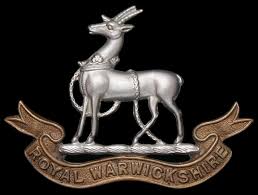Personal Details
Born: John was born on the 13 March 1893.
Family: The second son of William Morgan and Mary Ann Madeley. The family were living in Brownlow Street, Whitchurch, Shropshire when John was born. The 1901 Census shows them living at Oddfellow’s Cottage, Whitchurch, Shropshire and in 1911 at The Fleece, 22 Hope Street, Wrexham, Wales where William Madeley was the publican. In 1919 John married Minnie Jones.
Civilian Occupation: In 1911 John was working as a barman at his father’s pub although when he enlisted in 1915 his occupation was hairdresser. In 1939 he was employed as a haulage contractor.
Residence: When war broke out, he lived in Churton Road, Farndon, Cheshire. In 1939 he was living at Corner House, Woodbank, Chester, Cheshire.
Died: In 1966 aged 73.
Other Information: It appears that during the war he became known as ‘Jack’. He is the brother of William Alfred Madeley
Military Details
Regiment: Royal Warwickshire Regiment (previously Welsh Horse, Duke of Cambridge’s Own (Middlesex Regiment) and 9th Lancers)
Rank: Private
Service Number: 29913 (previously 725, 41690 and 17229)
Date of Enlistment: 13 January 1915
Date of Discharge: 3 March 1919
Reason for Discharge: Demobilisation
Other Information: He fought in France from 1 December 1916 until the 8 November 1917 when he was wounded and shipped back to England.
John was awarded the Campaign Medals (British War Medal, and Victory Medal).

The British War Medal (also known as 'Squeak') was a silver or bronze medal awarded to officers and men of the British and Imperial Forces who either entered a theatre of war or entered service overseas between 5th August 1914 and 11th November 1918 inclusive. This was later extended to services in Russia, Siberia and some other areas in 1919 and 1920. Approximately 6.5 million British War Medals were issued. Approximately 6.4 million of these were the silver versions of this medal. Around 110,000 of a bronze version were issued mainly to Chinese, Maltese and Indian Labour Corps. The front (obv or obverse) of the medal depicts the head of George V. The recipient's service number, rank, name and unit was impressed on the rim.
The Allied Victory Medal (also known as 'Wilfred') was issued by each of the allies. It was decided that each of the allies should each issue their own bronze victory medal with a similar design, similar equivalent wording and identical ribbon. The British medal was designed by W. McMillan. The front depicts a winged classical figure representing victory. Approximately 5.7 million victory medals were issued. Interestingly, eligibility for this medal was more restrictive and not everyone who received the British War Medal ('Squeak') also received the Victory Medal ('Wilfred'). However, in general, all recipients of 'Wilfred' also received 'Squeak' and all recipients of The 1914 Star or The 1914/1915 Star (also known as 'Pip') also received both 'Squeak' and 'Wilfred'. The recipient's service number, rank, name and unit was impressed on the rim.

